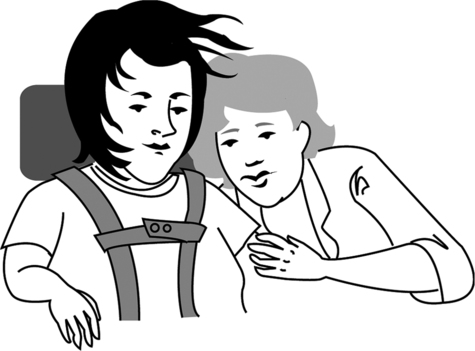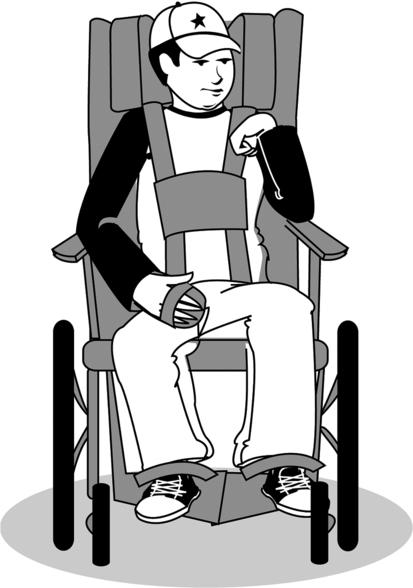15 After studying this chapter, the reader will be able to accomplish the following: • Identify possible causes of intellectual disabilities. • Differentiate the classifications of intellectual disabilities. • Identify adaptive functioning for each level of intellectual disabilities. • Identify the amount of support needed for each level of intellectual disabilities. • Explain the roles of the occupational therapist and the occupational therapy assistant in assessments of and interventions with children who have intellectual disabilities. An intellectual disability is a developmental disorder that occurs before the age of 18 years and is characterized by significantly below-average intellectual functioning as well as deficits in two or more adaptive skill areas (e.g., ADLs, communication, social participation, education, play/leisure, homemaking skills, and skills required to attain and maintain independence).1 Children with intellectual disability may appear different. Some children have conditions or syndromes (e.g., Down syndrome) and present with certain physical features as well as associated intellectual disability. Other children may exhibit no atypical physical characteristics. In general, parents and professionals suspect intellectual disability when a child fails to meet developmental milestones. Some children with mild disability may not be identified until they begin school. Unlike learning disability, which affects one area of learning (e.g., math or reading), intellectual disability impacts learning in all areas of one’s occupation. The diagnosis of intellectual disability involves consideration of the child’s cultural, linguistic, behavioral, sensory, motor, and communication abilities and, in particular, how those abilities may influence intelligence testing. Professionals consider the child’s age, strengths, and weaknesses, along with the limitations in intelligence when examining how these factors influence adaptive functioning.2 Health care professionals not only provide the diagnosis, they are also interested in providing information to develop an individualized plan of needed supports that will improve the child’s ability to participate in occupations. Although intellectual disability is now the preferred term used to describe children with intellectual and adaptive functioning deficits, the terms mental retardation and intellectual disability are classified and defined synonymously in the Diagnostic and Statistical Manual of Mental Disorders, 4th edition (DSM-IV-TR).1 Current federal and state laws contain the term mental retardation, and laws and public policy use this term to determine eligibility for state and federal programs. Formal testing procedures are used to diagnose children with intellectual disability and to gather information from interviews with parents, observations of the child, and completion of norm-referenced tests. The diagnosis of intellectual disability is made when a child scores significantly below average on intelligence testing (standardized tests) and experiences deficits in two or more areas of adaptive functioning (which may be identified through tests as well). Information gathered from parent interviews and observation of the child is considered to create the child’s profile and an intervention plan. The level of severity of intellectual disability is therefore determined by examining the results of intelligence testing, adaptive functioning, and mental age in conjunction with information from parents and from observation of the child.1 An intelligence quotient (IQ) is a score derived from one of several different standardized tests designed to assess intelligence. Scores from tests of intelligence are a primary tool for identifying children who have intellectual disability. Intelligence tests are scored on a scale of 0 to 145, with the average score of 100 and a standard deviation of 15 points. Table 15-1 describes the categories of intellectual disability according to IQ scores.4 TABLE 15-1 Categories of Intellectual Disability Based on Intelligence Quotient Scores Scores between 85 and 115 are considered within normal limits (average intelligence quotient). Children who score between 70 and 84 fall within the borderline intellectual disability range; a score between 55 and 69 represents mild intellectual disability a score between 25 and 39 is considered to represent severe intellectual disability and children with scores lower than 25 are classified as having profound intellectual disability.4 Adaptive functioning refers to the conceptual, social, and practical abilities that children rely on to adapt to changing environments and to function in their everyday lives. Conceptual skills include receptive and expressive language, reading and writing, money concepts, and self-direction. Social skills refer to self-esteem, social problem solving, and the ability to follow rules, obey laws, and avoid being victimized. Practical skills include ADLs, occupational skills, health care, travel/transportation, schedules/routines, safety, use of money, and use of the telephone. Limitations in these areas significantly interfere with a child’s ability to navigate through everyday situations.1,2 • The Vineland Adaptive Behavior Scale uses parental input to evaluate adaptive behavior in terms of communication, daily living, socialization, and motor skills. • The School Functional Assessment uses input from the teacher to assess the child’s ability to perform the occupational tasks necessary in the school setting. • The Support Intensity Scale (SIS) measures the pattern and level of support required for an adult with intellectual disability to lead a normal, independent life.10 The SIS measures the support required in the medical, behavioral, and life activity areas and also addresses the frequency, time of day, and type of support required. This is beneficial when developing support plans and can assist with resource allocation and financial planning.8 The incidence of intellectual disability in the United States is reported to be 3 out of every 100 people.2 Causes include genetic factors, problems during pregnancy, difficult births, and health problems. In many cases, the cause remains unknown. Children who have intellectual disability can also have physical and psychological disabilities. These deficits can include visual impairments, hearing loss, muscle tone problems, seizures, and sensory disorders (see Chapters 12, 16, and 24). Physicians often categorize the causes of intellectual disability on the basis of when they occur. Prenatal causes occur before birth, perinatal causes occur at birth, and postnatal causes occur from birth to 3 years of age. A teratogen is any physical or chemical substance that may cause physical or developmental complications in the fetus.5 Teratogens can include prescription medications, lead, alcohol, or illegal drugs consumed by the mother; maternal infections; and other toxins. The effects of teratogens on the fetus range from congenital anomalies (defects) to intellectual disability. The type of agent, the amount of exposure, and the point at which exposure occurs during embryonic and fetal development play important roles in the outcome. Exposure to teratogens during the first 12 weeks of pregnancy can have the most dangerous consequences because it is during this time that the fetal brain, spinal cord, most internal organs, and limbs develop. Infants born before completion of the thirty-seventh week of gestation are considered premature.9 Numerous factors may cause prematurity, such as poor nutrition, lack of prenatal care, toxemia, multiple fetuses, a weak cervix, numerous previous births, and adolescent mothers.7 Although prematurity does not necessarily mean that a disability will develop, some complications caused by prematurity may result in intellectual disability. For example, prematurity can cause respiratory distress syndrome (RDS), a condition in which the premature infant’s lungs are not yet producing surfactant, a chemical on the surface of the lungs that helps keep the lungs from collapsing. Another complication of prematurity is apnea, a condition in which the infant stops breathing; apnea can last from seconds to minutes. Anoxia refers to a total lack of oxygen, while hypoxia refers to a decreased amount of oxygen.9 Intellectual disability can result when either condition affects the brain. The severity of brain dysfunction depends on (1) the location and size of the area deprived of oxygen; (2) the amount of time the area is without oxygen; and (3) the metabolic changes that take place in the body as a result of cell death in that area of the brain. Anoxia or hypoxia can occur during labor because of a small birth canal, which can result in bleeding around the baby’s brain, compression of the umbilical cord, tearing of the placenta (placenta previa), or breech birth (i.e., the child is born with the buttocks presenting first instead of the head as in normal births). Prematurity can also cause hydrocephalus, a condition in which the cerebrospinal fluid accumulates in the brain and can cause the head to grow disproportionately large (Figure 15-1). The extent of the infant’s prematurity and associated complications affects the severity of the impairment (if any develops). Premature brain development puts infants at risk for brain hemorrhages (bleeding). Infections can cause brain damage and resulting intellectual disability in infants and children. Viral meningitis is a condition in which a virus attacks the protective covering around the brain and spinal cord, known as the meninges.7 Several different viruses cause meningitis, including chickenpox virus. In small children and infants, meningitis may cause permanent brain damage that results in intellectual disability, the severity of which depends on the extent of brain damage. Inflammation of the brain, known as encephalitis, may be caused by complications from the mother contracting chickenpox, rabies, measles, influenza, and other diseases.9 The severity of any resulting intellectual disability varies depending on the area and amount of the brain damaged. Toxins are poisonous substances that cause particular problems when ingested.9 Because infants and small children often place objects and substances in their mouths, certain common household substances can pose serious and life-threatening problems. For example, older homes often have lead-based paint on the walls. Inhaling, licking, or eating peeling paint can cause lead poisoning, resulting in developmental problems. Once diagnosed, lead poisoning can be treated, but residual permanent damage may exist. Other common household toxins include mercury in thermometers and cleaning agents. The capacity of a child with an intellectual disability to perform in areas of occupation varies depending on the severity of intellectual disability and the presence of additional deficits. Regardless of intellectual disability, “all people need to be able or enabled to engage in the occupations of their need and choice, to grow through what they do, and experience independence or interdependence, equality, participation, security, health and well being” (p. 198).6
Intellectual disabilities
Definition
Measurement and classification
Intelligence testing
RANGE OF IQ SCORES
INTELLECTUAL DISABILITY CATEGORY
55 to 69
Mild
40 to 54
Moderate
25 to 39
Severe
Less than 25
Profound
Adaptive functioning
Etiology and incidence
Prenatal causes
Acquired causes
Perinatal causes
Prematurity
Postnatal causes
Infections
Teratogens
Performance in areas of occupation
![]()
Stay updated, free articles. Join our Telegram channel

Full access? Get Clinical Tree


Intellectual disabilities


